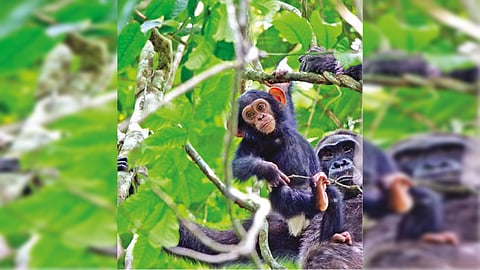

In the misty forests of the Congolese rainforest, a small band of apes fed in a tree. Adult chimpanzees dined on fruit in the canopy, while a pair of young apes played nearby. But one of the playing apes was not a chimpanzee: It was a gorilla.
“Most of what we’d been told about the interactions between these two species is that they’d be competitive or they would avoid each other,” said Crickette Sanz, an anthropologist at Washington University in St. Louis who witnessed such a scene for the first time in 2000. But over two decades of observations at Nouabalé-Ndoki National Park in the Republic of Congo, she and her colleagues recorded years-long relationships and other forms of social interactions between individual chimpanzees and gorillas. Their research was published last month in iScience.
While the populations of chimpanzees in East and West Africa have been well studied over the past several decades, the bands present in Congo are less well known, Sanz said. Their range overlaps with the region containing a majority of remaining gorillas, particularly within the remote Goualougo Triangle.
From 1999, Sanz and her colleagues embarked on a long-term study of a band of Goualougo chimps. Over the course of daily excursions following them through the forest, the team documented 285 interactions between the two species, over encounters lasting from a minute to more than eight hours. Often, Sanz said, interactions occurred after a band of chimps located an exciting meal, such as a fruiting strangler fig or kapok. The sound of excited chimpanzees would draw in a family group of gorillas. In 34% of the encounters, the two ape bands went on to co-feed in the same tree, or forage alongside each other for different foods.
The interactions the team saw were “generally tolerant,” Sanz said, and occasionally actively friendly. The larger gorillas tended to approach chimpanzee mothers more often than males or childless females. From there, different individuals paired off to chase one another, wrestle and generally rough-house. These relationships tended to last for years, the team found: Upon encountering a band of the other species, particular apes sometimes scanned it and then made a beeline for individuals they knew.
These interactions weren’t random. Social apes occasionally stepped on one another’s toes, and the team noted moments of friction. But aggressive interactions rarely got beyond yelled warnings, and never escalated to the kind of lethal interspecies attacks seen at sites in Gabon.
These sorts of groupings don’t seem to help ward off predation, Sanz and her colleagues found. Instead, maintaining friendly relationships seems to open up new feeding opportunities, with apes of different species sometimes alerting one another to fruits that are harder to spot. Co-feeding, in turn, gives apes a chance to make lasting relationships.
The presence of peaceable interactions between two species of great ape has intriguing implications for our own evolutionary history. Anthropologists have often assumed that various species of hominin actively competed with one another, Sanz said. But if chimps and gorillas are any indication, humanity’s ancestors may also have come together to share resources on the landscape — a possibility hinted at by the amount of interbreeding between different hominin species.
Visit news.dtnext.in to explore our interactive epaper!
Download the DT Next app for more exciting features!
Click here for iOS
Click here for Android